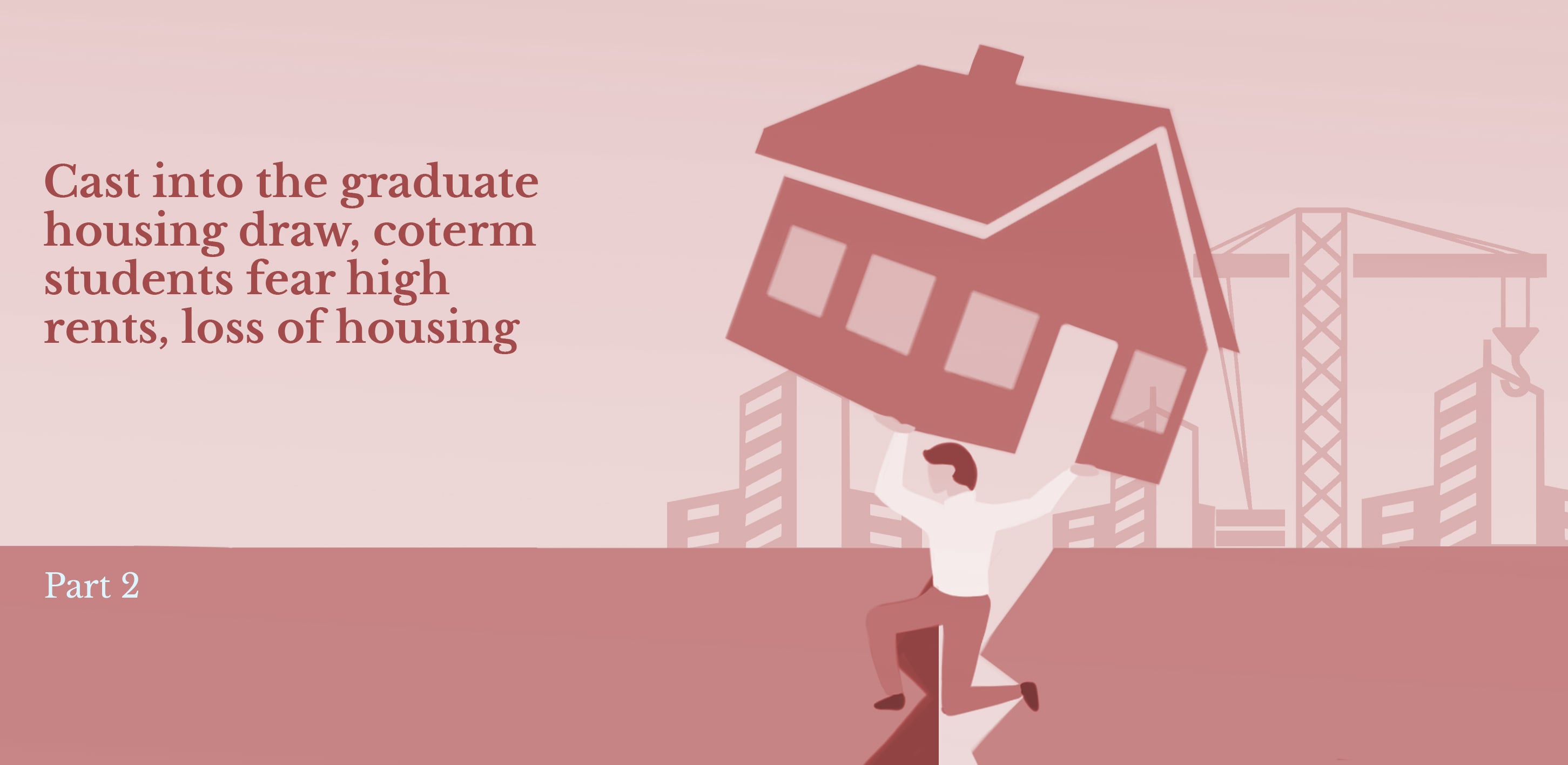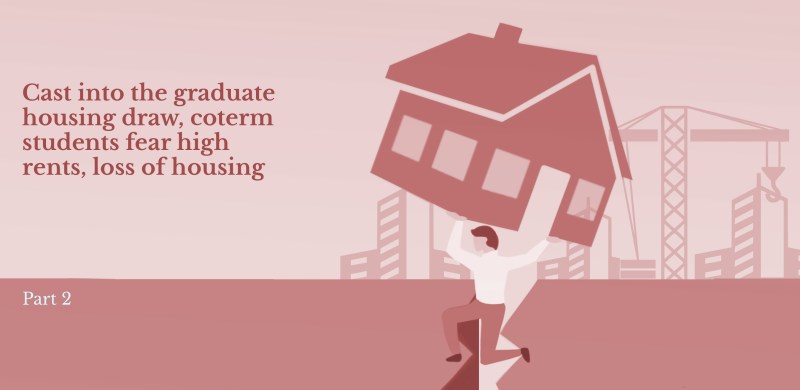
By Tammer Bagdasarian on June 9, 2021
This is the second installment in a series about the challenges of housing insecurity that graduate students face at Stanford.
Coterminal students are facing unexpected affordability concerns and housing insecurity after Stanford reversed a policy that guaranteed coterms the opportunity to use any remaining quarters of undergraduate housing in their fifth academic year.
Now effectively forced to enter the graduate housing draw following the last-minute change, some coterms are unsure of whether they will be able to afford the higher cost of Stanford graduate housing, while others worry that they may not even receive on-campus housing at all.
When Jane Boettcher ’21 M.S. ’22 first heard from a friend in June that she was no longer guaranteed housing and would have to apply through the graduate housing draw, she was thrown into a world of uncertainty.
“It was mostly disbelief,” Boettcher said. “I wasn’t willing to accept that it was true. And then I started getting a little bit more worried, but I still thought it was false. One, it didn’t make sense, and two, I would have received much more communication about this to make me aware. And then I was freaking out when I realized it was true.”
Housing insecurity at Stanford has been a repeated pain point for graduate students during the COVID-19 pandemic. Consistently rising on-campus rents, paired with a complex landlord-tenant dynamic that limits advocacy opportunities for students, have resulted in a tenuous relationship between students and administrators.
Traditionally, some coterm students fall into the housing classification of graduate students, but not all. The blurry line between undergraduate and graduate status for coterms at Stanford means that many elect to study abroad or take leaves of absence in order to save undergraduate housing quarters for their fifth academic year. Additionally, many wait to confer their bachelor’s degree until their fifth year in an effort to keep more financial aid options open.
Students’ academic and financial decisions are driven by guidance from advisors and fine print administrative policies that can often be vague and unreliable, according to multiple students. One such policy was the undergraduate housing guarantee, which had formerly declared that coterms would not only be allowed but would also be required to live in “undergraduate housing for their four years of guaranteed undergraduate housing regardless of student status.”
In May, however, the University’s messaging to coterms changed. Residential and Dining Enterprises (R&DE) told coterms that they were “strongly encouraged” to enter the graduate housing draw, and the message on the R&DE FAQ page changed, no longer mentioning the 12 quarters of guaranteed undergraduate housing.
Though R&DE conveyed its sentiment of strong encouragement to coterms prior to the housing draw, multiple students said they glossed over the ostensibly harmless message, which many read as little more than advice: “a strong recommendation is very different from them saying ‘you actually have to apply,’” Boettcher said. In actuality, coterm students are essentially required to apply through the graduate draw.
“Coterms are not guaranteed a space in undergraduate housing simply because demand has really excelled,” said director of student housing assignments Justin Akers. “We wanted to prioritize students who are true undergrads.”
The change in demand was catalyzed by an unexpectedly large increase in the size of the 2021-22 academic year’s undergraduate population. The undergraduate population spike stems in large part from the unusually large number of students who deferred admission to the upcoming year, as well as an increase in the number of would-be graduating seniors who took leaves of absence, Akers said.
With an oversized undergraduate population, it is unlikely that the undergraduate housing options will be able to accommodate coterm students, Akers said. But the last-minute policy change has numerous ramifications for this year’s class of coterms, who feel they have been placed at the bottom of the totem pole.
One major area of concern, students said, is affordability. While the majority of undergraduate options (excluding the Mirrielees House apartments) cost $3,722 per quarter, most graduate student housing rates fall between $1,500 and $2,500 per month, meaning that they can total more than twice the undergraduate rates in a quarter. For students who have been financially battered by the pandemic, the extra cost can be the difference between a stable housing situation and potential homelessness. As an undergraduate at Stanford, financial struggles once pushed Zack Boyd ’21 M.A. ’22 to live in his car. He doesn’t want to be forced into a similar situation again, he said.
“I feel less scared of that fact now, but I don’t know,” Boyd said. “I don’t think I could find affordable housing in Palo Alto, or close enough where it’s reasonable to commute. I think it’s easy for them to forget, or not even be aware of the experiences of certain students.”
Representatives within the Graduate Student Council have lobbied R&DE to match undergraduate rates within coterm graduate housing. Akers said on June 16 that he would bring up the prospect, but said at a recent meeting that R&DE will not be able to make decisions until after assignment is complete.
Even for students who may be able to swallow the extra cost, however, living on campus is not a guarantee. Coterm students have the lowest priority in the housing draw, and many already missed the first and second rounds of the graduate housing draw because they did not understand the policy change, Chloe Glikbarg ’21 M.S. ’22 said.
According to Akers, it is highly likely that the University will be able to accommodate all coterms who apply, even though there is no official guarantee.
“No one’s going to be homeless, we’re gonna have housing for everyone,” Akers said. “It just might not be in undergraduate housing. It’ll be in graduate housing instead of undergraduate housing.”
In addition to affordability and housing insecurity concerns, coterms also face a high likelihood of being placed in housing options near the bottom of their rankings. The loss of high-tier housing is just one in a long list of “bait-and-switches” that coterms have had to deal with.
“I think that they should grandfather in students for whom the policy was not widely publicized when they applied,” Glikbarg said. “I definitely feel blindsided by the policy. I feel like it would have affected my decisions and maybe I would have chosen something else. It’s being retroactively applied to us in a way that I think is very unfair.”
In recent weeks, R&DE has attempted to provide coterms with clear guidance by sending out emails and including more information about coterm housing on the undergraduate housing application. Though coterms said they appreciate the added clarity, many remain frustrated with how the policy change was dealt with.
“In the case of housing, the University should be crystal clear about what this is and what it is going to impact,” Boyd said. “There are people I know for whom this university is their first stable housing in life. That’s a big, big deal and you shouldn’t be ambiguous about it. I think people underestimate how important housing is to so many of us.”
